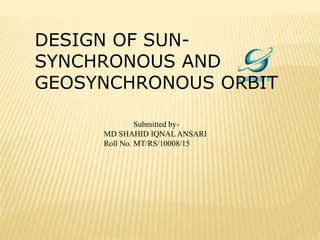DESIGN OF GEOSYNCHRONOUS AND SUN SYNCHRONOUS ORBIT
•Transferir como PPTX, PDF•
2 gostaram•1,504 visualizações
BIT MESRA
Denunciar
Compartilhar
Denunciar
Compartilhar

Recomendados
Recomendados
Mais conteúdo relacionado
Mais procurados
Mais procurados (20)
Types of satellite metrological & resource satellites

Types of satellite metrological & resource satellites
Destaque
Destaque (6)
Multiple access techniques for wireless communications

Multiple access techniques for wireless communications
Semelhante a DESIGN OF GEOSYNCHRONOUS AND SUN SYNCHRONOUS ORBIT
Semelhante a DESIGN OF GEOSYNCHRONOUS AND SUN SYNCHRONOUS ORBIT (20)
Geodetic Astronomy - MOTION IN THE HEAVENS - EARTH, SUN AND STARS

Geodetic Astronomy - MOTION IN THE HEAVENS - EARTH, SUN AND STARS
Último
Process of Integration the Laser Scan Data into FEA Model and Level 3 Fitness-for-Service Assessment of Critical Assets in Refinery & Process IndustriesFEA Based Level 3 Assessment of Deformed Tanks with Fluid Induced Loads

FEA Based Level 3 Assessment of Deformed Tanks with Fluid Induced LoadsArindam Chakraborty, Ph.D., P.E. (CA, TX)
Último (20)
DC MACHINE-Motoring and generation, Armature circuit equation

DC MACHINE-Motoring and generation, Armature circuit equation
Double Revolving field theory-how the rotor develops torque

Double Revolving field theory-how the rotor develops torque
FEA Based Level 3 Assessment of Deformed Tanks with Fluid Induced Loads

FEA Based Level 3 Assessment of Deformed Tanks with Fluid Induced Loads
Verification of thevenin's theorem for BEEE Lab (1).pptx

Verification of thevenin's theorem for BEEE Lab (1).pptx
1_Introduction + EAM Vocabulary + how to navigate in EAM.pdf

1_Introduction + EAM Vocabulary + how to navigate in EAM.pdf
"Lesotho Leaps Forward: A Chronicle of Transformative Developments"

"Lesotho Leaps Forward: A Chronicle of Transformative Developments"
S1S2 B.Arch MGU - HOA1&2 Module 3 -Temple Architecture of Kerala.pptx

S1S2 B.Arch MGU - HOA1&2 Module 3 -Temple Architecture of Kerala.pptx
PE 459 LECTURE 2- natural gas basic concepts and properties

PE 459 LECTURE 2- natural gas basic concepts and properties
DESIGN OF GEOSYNCHRONOUS AND SUN SYNCHRONOUS ORBIT
- 1. DESIGN OF SUN- SYNCHRONOUS AND GEOSYNCHRONOUS ORBIT Submitted by- MD SHAHID IQNAL ANSARI Roll No. MT/RS/10008/15
- 2. INTRODUCT ION What is an Orbit? An orbit is a regular, repeating path that one object in space takes around another one. An object in an orbit is called a satellite. A satellite can be natural, like Earth or the moon. Many planets have moons that orbit them.
- 3. DEFINITION OF SYNCHRONOUS ORBIT A synchronous orbit is an orbit where the orbital period equals the rotation rate of the orbited body. That is, an orbiting body (usually a satellite) has a period equal to the average rotational period of the body being orbited (usually a planet), and in the same direction of rotation as that body. So, the synchronous orbit is where the satellite has a period equal to the average rotational period of the planet.
- 4. ORBIT TYPES Synchronous types are : Sun-synchronous orbit : An orbit which combines altitude and inclination(angle between reference place and orbital plane) in such a way that the satellite passes over any given point of the earth surface at the same local solar time. It orbits at 700-800km altitude over the Earth surface and always same orientation Geostationary orbit : An orbit around the Earth with an orbital period matching the Earth’s sidereal rotation period . It lies in the equatorial plane around earth. A satellite in such an orbit is at an altitude of approximately 35,786 km .
- 5. SUN SYNCHRONOUS ORBIT Rate is equal to average rate of Earth’s rotation around the sun Position of Sun relative to orbital plane remains relatively constant Sun Synchronous orbits can be achieved around other central bodies Usually near 90º inclinations
- 6. Sun-Synchronous: The satellite is always in the same relative position between the Earth and Sun. Equatorial-Crossing Time: The local apparent solar time when the satellite crosses the equator. Example: Terra has an equatorial crossing time of 10:30 am, and is called an “AM” or morning satellite. Ascending Orbit: The satellite is moving South to North when that portion of the orbit track crosses the equator. Descending Orbit: The satellite is moving North to South when that portion of the orbit track crosses the equator. Period: A typical polar, Sun- synchronous LEO satellite takes about 90 minutes to completely circle the Earth. This gives it about 16 orbits per day. Low Earth Orbit: Orbiting at an altitude of 600-1,000 km. 6
- 7. A geosynchronous orbit is an orbit around the Earth with an orbital period of one sidereal day, intentionally matching the Earth's sidereal rotation period approximately 23 hours 56 minutes and 4.9 seconds. The synchronization of rotation and orbital period means that, for an observer on the surface of the Earth, an object in geosynchronous orbit returns to exactly the same position in the sky after a period of one sidereal day. GEO-SYNCHRONOUS ORBIT
- 8. ORBIT DESIGN PROCESS Step 1: Establish Orbit Types Earth referenced orbits GEO, LEO Space referenced orbits Lagrange points, planetary Transfer orbit GTO, Interplanetary Parking orbit Temporary orbit for satellite operational checks, EOL
- 9. OUTLINE Orbit Design Orbit Selection Orbit Design Process ΔV Budget Launch Earth Coverage Constellation Design Basic Formation Stationkeeping Collision Avoidance
- 10. ORBIT DESIGN PROCESS Establish Orbit-Related Mission Requirements Altitude Resolution Lower altitude is better Swath width Higher altitude is better Inclination Ground station coverage Lifetime Survivability (ambient environment) Must be able to survive the entire orbital profile (e.g. transit through Van Allen Radiation Belts)
- 11. EARTH COVERAGE
- 12. THANK YOU